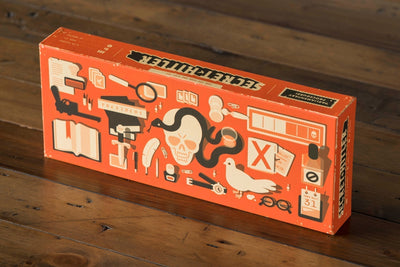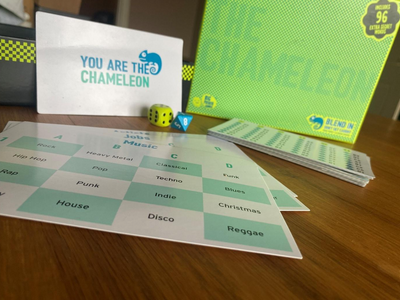Speakeasy- You and Me and the Bottle Makes Three

Brian Garmon (BGG- Jareck80)
A few weeks ago, I returned home from work to see that familiar, exciting sight on the porch… a shipping box emblazoned with the Eagle Griffon Games (EGG) label that could only mean one thing. Vital Lacerda’s new heavy Euro, Speakeasy, had arrived.

Table of Contents
Introduction
For those of you unfamiliar with Lacerda’s work, let me set the stage. Vital is known for designing highly intricate, interconnected Euros that blend deep strategic planning with strong thematic integration. His games often feature elegant but demanding systems where every action has cascading consequences, rewarding efficiency, foresight, and repeated plays.
They’re heavy, they’re crunchy, and they’re some of my favorite designs to play.
So, what exactly IS Speakeasy?
Speakeasy casts you as a Prohibition-era mob boss in 1920s Manhattan vying for dominance via speakeasies, nightclubs and casinos against rival player families; protecting against increasing police pressure; and defending neighborhoods against takeovers from non-player mobsters. You’ll manage and upgrade tracks to make your bootlegging enterprise more effective, deploy synergies with worker placement spaces and action cards, gain infamy, position your empire for territory control, and collect cash from your illicit activities, with the goal of accumulating the most money by game’s end.
Now that that’s out of the way, back to my delivery…
Like a kid on Christmas morning, I picked up the box and ran inside, voraciously tearing into the packaging, revealing a game box that was bigger than the standard EGG fare, which just meant more cardboard goodness waited inside.
Two things struck me after opening the (very heavy) box, punching the bits, and repacking them into the insert using the handy dandy guide (publishers take note):
- This is one of the best and most functional inserts that has accompanied a Lacerda title in a long while.
- Holy smokes, that’s a LOT of wood and cardboard. (more to come on this later)
In the two weeks since arriving, I’ve managed to play twice, both 3p games, with two different opponents in each play, so I feel like I have enough game under my belt to give some general thoughts and impressions.

The Theme
First and foremost- the theme on this game delivers! Whereas many heavy games fall into the trap of including mini-loops and mechanisms for their own sake, Speakeasy feels like every action is in service of building your bootlegging empire.
The game isn’t populated by workers or meeples: you have Capos, family members, and goons interacting with police and mobsters. You’re establishing footholds in contested neighborhoods with speakeasies, nightclubs, and casinos and watching the docks for rumrunners who could provide you some quick booze, for a price, or make a juicy target, ripe for the picking. Each has their unique place and role within the gameplay and notably, at the end of our games, we’re still referring to these pieces and parts by their actual game-names instead of the usual abstracted, “piece, worker, meeple, thing,” etc. For me, that’s one way I know the theme really sticks to the ribs.
Finally, Speakeasy uses the framework of Lucky Luciano’s commission to avoid direct player conflict. You’re competing among other players to be the most profitable in the commission, but you’re not actively fighting one another, which places the focus solely on executing the game loop and squeezing the most out of your limited actions.

Learning the Game
The initial teach can be daunting, probably a 30-45 minute endeavour, but Ian O’Toole’s smart graphic design and iconography provides an intuitive framework that helps players spend more time thinking through the game’s puzzle rather than fishing through a rulebook trying to remember what a confusing icon actually means. O’Toole’s ability to quickly establish effective instructional tools in his graphic design impresses me every time I play one of his designs.
Each of the 19 worker placement spaces offers a different combination of core actions, unique to a location, and other supplemental actions, that may be acquired from multiple locations. While the sheer number of spaces and actions available might make you think that the game might devolve into a mess of a sandbox, the tight core loop of build buildings-produce booze-deliver booze-sell booze gives players a compass to guide them while the expansive choices to accomplish the steps allows the players to map their own path to victory.
One of my favorite inclusions in most, if not all, Lacerda titles is the “how to” tips page. In Speakeasy, this is in the main rulebook, and it puts up simple answers to questions like, “how to earn money,” “How to gain infamy,” and offers some tips that players shouldn’t avoid, lest you end up like me and have your still destroyed less than halfway through a game!
Gameplay
Ok, we’ve talked about how the game plays in the abstract, so let’s take a few minutes to discuss the nitty gritty.
Players will take 11 actions over the course of 4 eras. On each player turn, you’ll have the opportunity to play a “helper” card, place a Capo on one of the 19 aforementioned worker placement spaces, taking the actions defined by the location and the particular slot at the location, then draw a card. In typical Lacerda fashion, the simple structure camouflages the underlying possibilities.
As a boardgamegeek poster noted, astutely, “His games are about doing more things per thing than other players.”
Cards, city tiles, and creative use of action spaces can chain together turns that generate multiple synergistic actions, particularly at the restaurant. When your Capo sits down at this location, you’re not only “chewing the fat” with other members of the commission, your brain is also chewing and digesting nearly endless possibilities of how to accomplish your next wily move.
In-between each era, new mobsters move in on randomly selected neighborhoods and the police increase their presence (the game does give you a slight heads-up these are coming).
Time is your enemy, much like in other action-constrained games like Pipeline (another of my favorites). Scores are measured in the hundreds, but victories can be measured by just a few dollars.
When I described Vital’s games earlier, I mentioned the value in replaying his titles. This directly reflected in my scores between my first and second games- I increased my score by nearly 33% by exploring different ways to squeeze every ounce of illegal booze from my still.
An Imperfect Gem
If you can’t tell by now, I really enjoyed Speakeasy, but it’s not without its flaws that should be considered before you try or buy.
Table Space
If you’re going to play Speakeasy, you need a table, or should I say, A TABLE. I have a large oval dining room table that’s close to 6x4 and Speakeasy found a way to use every inch. Going forward, when we play this one, I’ll be using my rectangular gaming table, as the extra inches gained by the rectangular shape will be a welcome addition to the table sprawl (my gaming table is also 6x4, similar to this Kingswood table). If you’re using a gaming table, unpack those cupholders, because you’re not going to have room on the tabletop.
As I mentioned while discussing the unboxing, there are also A LOT of bits, chits, and parts. Break out your silicon muffin cups or, if you’re feeling fancy, your bit trays, because while the insert is very good, having multiple supplies of the extra components on either side of the table is a must. Without something to keep your table sorted, you could drown under the wave of bits.
This game is indicative of the trend games are taking towards being ever more sprawling, and I think designers need to draw the metaphorical line in the sand and consider retreating to a more reasonable table presence.

The Struggle is Real
If you’re not a heavy gamer or you’re looking for a beer and pretzels-type game on a schoolnight, Speakeasy may not be on your menu. Expect intense decisions where everything you do has a butterfly effect. Gamers or game groups that are prone to analysis-paralysis will find this one hard to keep a steady pace through. Each of our 3p games (with new players) took about 3 hours, even with players who are used to heavy games. I think a 4p game would have easily topped out at 4.5 hours.
I think that 3p is the sweet spot for early plays, but I could see 4p games finishing in 3ish hours once the group has a few plays under their belts.
My Conclusion
For me, Speakeasy is a slam dunk. It’s been living rent-free in my head since my first play, and for me, the theme-loving heavy gamer, it scratches that crunchy, puzzly itch in my brain perfectly. At the same time, I know this isn’t a game for everyone. Hopefully, my thoughts can help your group decide if Speakeasy deserves a place on its shelf.

Brian Garmon (BGG- Jareck80)
Brian has been a board gamer for as long as he can remember. Growing up on classic games like Chess, Clue, Monopoly, Risk, Samurai Swords, and Axis and Allies, it wasn't until the early 2000s that he was introduced to the larger gaming world via Settlers of Catan (now Catan).
Nowadays, Brian enjoys heavy Euro games at his weekly game night and also the lighter fare of gaming with his two teenagers. His also loves the 18xx train gaming genre. He enjoys attending gaming conventions and his dream job would be a marketing manager for a large gaming company.
Top 3 games of all time:
Age of Steam
Indonesia
Pax Pamir 2nd Edition





